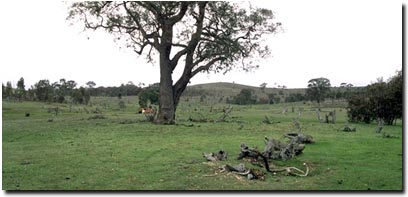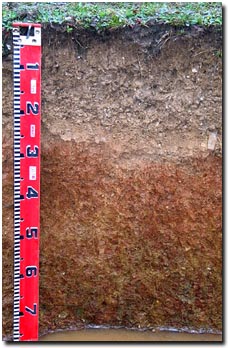LP81
Location: Frenchmans
Australian Soil Classification: Mottled, Eutrophic, Red CHROMOSOL (gravelly)
Northcote Factual Key: Dy 3.41
General Landscape Description: Footslopes of Pyrenees Ranges.
Geology: Tertiary river gravel deposits (on alluvial apron along base of Pyrenees Range) and/or Quaternary colluvium.
Original Vegetation: Includes Red Box (Eucalyptus polyanthemos).
 LP81 Landscape |
Soil Profile Morphology:
Surface Soil
| A1 | 0-5 cm | Brown (7.5YR4/4); fine sandy loam; few quartz gravels on surface; massive; weak consistence moist; pH 5.5; abrupt and wavy change to: |  LP81 Profile |
| A2 | 5-25 cm | Brownish yellow (10YR6/6) conspicuously bleached (10YR7/3d); fine sand (becoming fine sandy loam with depth); weak consistence moist; contains a few (5%) ferruginous nodules; and very many (70%) quartz fragments (30 mm diameter); pH 5.8; abrupt wavy change to: | |
| Subsoil | |||
| B1 | 25-27 cm | Yellowish red (5YR5/8); fine sandy light clay; moderate medium polyhedral structure; pH 6.2: | |
| B21 | 27-45 cm | Yellowish red (5YR5/8); medium clay; medium coarse blocky, parting to strong fine polyhedral structure; sticky consistence wet; pH 5.7; gradual and wavy change to: | |
| B22 | 45-75 cm | Strong brown (7.5YR5/6) with dark red (2.5YR4/8) and dark red (2.5YR3/6) mottles; medium heavy clay; strong coarse blocky, parting to strong fine polyhedral structure; sticky consistence wet; contains a few (< 2%) quartz fragments (30 mm diameter); pH 5.4. | |
Key Profile Features:
- A2 horizon conspicuously bleached and very gravelly (70%).
- Strong texture contrast between surface (A) horizons and the upper subsoil (B21) horizon.
Soil Profile Characteristics:
pH | Salinity Rating | |||
Surface (A1 horizon) | Strongly Acid | Very Low | Non-Sodic | None1 |
Subsoil (B21 horizon) | Moderately Acid | Very Low | Non-Sodic | None |
Deeper Subsoil (at 60 m) | Strongly Acid | Very Low | Non-Sodic | None1 |

| The surface is strongly acid. The subsoil is moderately acid becoming strongly acid with depth. | The profile has a very low salinity rating throughout. | The profile is non-sodic throughout. |
Chemical and Physical Analysis:
Horizon | Horizon Depth (cm) | pH (water) | pH (CaCl2) | EC dS/m | Nitrogen % | Organic Carbon % | Exchangeable Cations | |||
Ca | Mg | K | Na | |||||||
Meq/100g | ||||||||||
A1 | 0-5 | 5.5 | 4.1 | 0.05 | 0.12 | 1.2 | 0.9 | 0.4 | 0.3 | <0.1 |
A2 | 5-25 | 5.8 | 4.8 | <0.05 | 0.4 | 0.2 | 0.2 | <0.1 | ||
B1 | 25-27 | 6.2 | 5 | <0.05 | 1.9 | 2.3 | 0.4 | <0.1 | ||
B21 | 27-45 | 5.7 | 4.6 | <0.05 | 2.3 | 4.4 | 0.7 | 0.1 | ||
B22 | 45-75 | 5.4 | 4.3 | <0.05 | 0.9 | 6 | 0.6 | 0.2 | ||
Horizon | Horizon Depth (cm) | Exchangeable Aluminium mg/kg | Exchangeable Acidity meq/100g |
A1 | 0-5 | ||
A2 | 5-25 | ||
B1 | 25-27 | ||
B21 | 27-45 | ||
B22 | 45-75 | 170 | 11.8 |
Management Considerations:
Whole Profile
- Much of the soil is moderately to strongly acid. This may lead to toxic levels of some nutrients (e.g. aluminium, manganese). To assess the economic viability of adding lime to raise the pH, further tests over a large area of this soil type should be performed and test strips of liming are recommended. Other factors need to be considered, however, before lime is recommended (e.g. type of pasture species grown, method of application, local trial responses, likely cost-benefit).
- The surface (A1) horizon is shallow at this site. This horizon is important in terms of plant growth as the deep subsurface (A2) horizon is infertile and very gravelly. The organic matter levels measured here are quite low for a pasture but may not necessarily be representative of the whole area. Organic matter is important in surface soils for enhancing soil fertility, aggregate stability and water holding capacity. Maintaining adequate surface cover is important to prevent sheet erosion and loss of surface soil.
- The surface horizons have a very low inherent fertility (based on the sum of the basic exchangeable cations).
- The high gravel content (70%) of the A2 horizon may cause root deflection of crop or pasture species with tap roots.
- The subsoil is moderately to highly acid and below 45cm depth the exchangeable Aluminium level is very high at 170 ppm. This can be a problem to even moderately sensitive plants and plants like lucerne and phalaris are particularly sensitive.
- The clay is well structured and non-sodic, which is favourable for root and water penetration.
- Currently stocking rate is low (1-2 sheep per acre).
- Native grasses mainly.
- Probably not worth improving due to being extremely gravelly.
Profile Described By: Mark Imhof, Paul Rampant, Sonia Thompson, Ruth Lourey and Karen De Plater (June 1995).


